
Sears
owners manual
MODEL NO.
113.299131
CAUTION:
Read SAFETY
RULES and
INSTRUCTIONS carefully
CRRFTSMRII
FL OOR SAW
assembly
operating
repair parts
Sears, Roebuck and Co., Chicago, III. 60684 U.S.A. and

Sears
owners manual
MODEL NO.
113.299131
CAUTION:
Read SAFETY
RULES and
INSTRUCTIONS carefully
CRRFTSMRII
FL OOR SAW
assembly
operating
repair parts
Sears, Roebuck and Co., Chicago, III. 60684 U.S.A. and
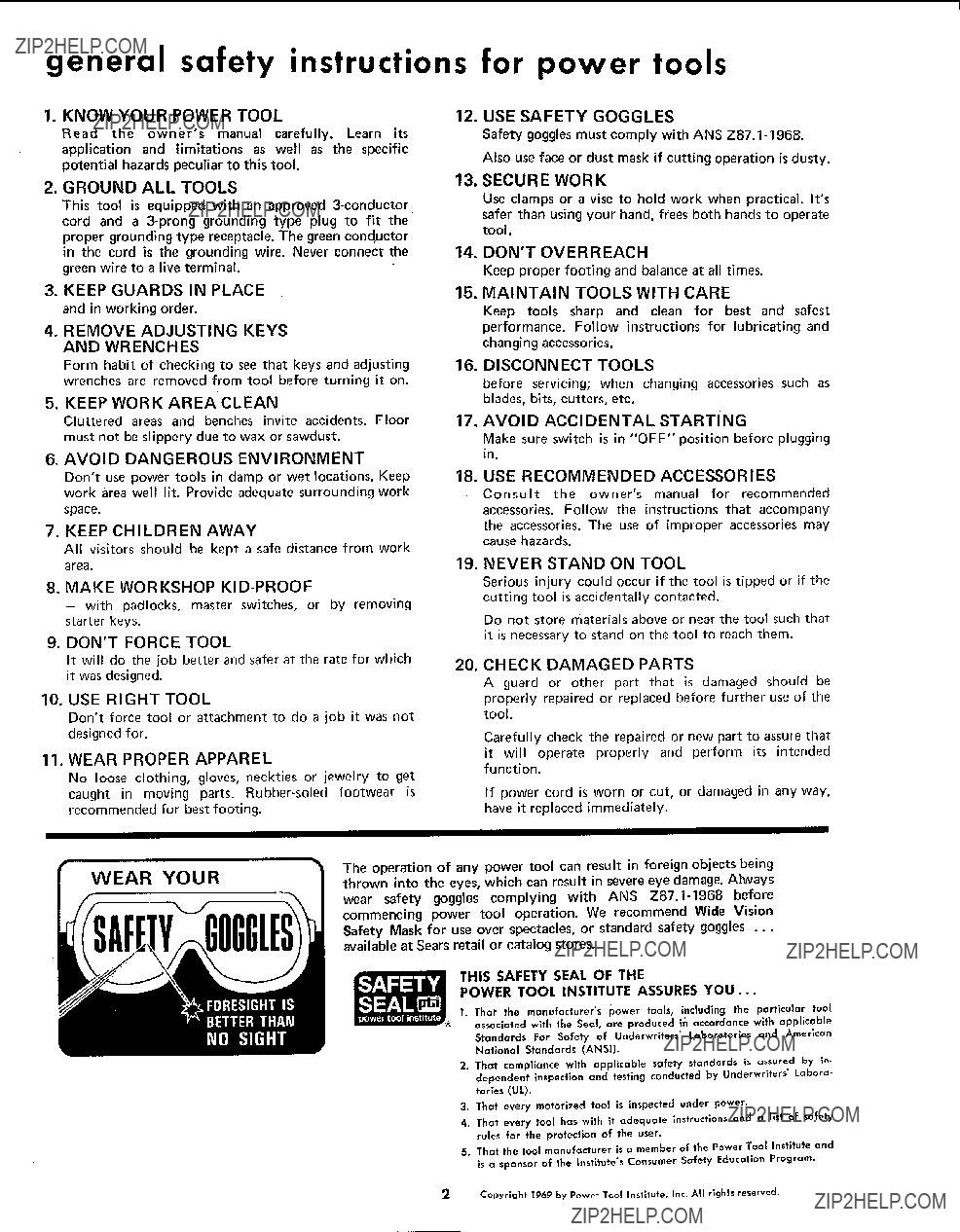
general safety instructions for power tools
Read the owner's manual carefully. Learn its application and limitations as well as the specific potential hazards peculiar to this tool.
Safety goggles must comply with ANS
Also use face or dust mask if cutting operation is dusty.
2.GROUND ALL TOOLS
This tool is equipped with an approved
3.KEEP GUARDS IN PLACE and in working order.
4.REMOVE ADJUSTING KEYS
AND WRENCHES
Form habit of checking to see that keys and adjusting wrenches are removed from tool before turning it on.
5.KEEP WORK AREA CLEAN
Cluttered areas and benches invite accidents. Floor must not be slippery due to wax or sawdust.
6.AVOID DANGEROUS ENVIRONMENT
Don't use power tools in damp or wet locations. Keep work area well lit. Provide adequate surrounding work space.
7, KEEP CHILDREN AWAY
All visitors should be kept a safe distance from work area.
8.MAKE WORKSHOP
-with padlocks, master switches, or by removing starter keys.
9.DON'T FORCE TOOL
It will do the job better and safer at the rate for which it was designed.
10.USE RIGHT TOOL
Don't force tool or attachment to do a job it was not designed for.
11.WEAR PROPER APPAREL
No loose clothing, gloves, neckties or jewelry to get caught in moving parts.
13.SECURE WORK
Use clamps or a vise to hold work when practical. It's safer than using your hand, frees both hands to operate tool.
14.DON'T OVERREACH
Keep proper footing and balance at all times.
15.MAINTAIN TOOLS WITH CARE
Keep tools sharp and clean for best and safest performance. Follow instructions for lubricating and changing accessories.
16.DISCONNECT TOOLS
before servicing; when changing accessories such as blades, bits, cutters, etc.
17.AVOID ACCIDENTAL STARTING
Make sure switch is in "OFF" position before plugging in.
18.USE RECOMMENDED ACCESSORIES
Consult the owner's manual for recommended accessories. Follow the instructions that accompany the accessories. The use of improper accessories may cause hazards.
19.NEVER STAND ON TOOL
Serious injury could occur if the tool is tipped or if the cutting tool is accidentally contacted.
Do not store materials above or near the tool such that it is necessary to stand on the tool to reach them.
20.CHECK DAMAGED PARTS
A guard or other part that is damaged should be properly repaired or replaced before further use of the tool.
Carefully check the repaired or new part to assure that it will operate properly and perform its intended function.
If power cord is worn or cut, or damaged in any way, have it replaced immediately.
The operation of any power tool can result in foreign objects being thrown into the eyes, which can result in severe eve damage. Always wear safety goggles complying with ANS
available at Sears retail or catalog stores.
THIS SAFETY SEAL OF THE
POWER TOOL INSTITUTE ASSURES YOU...
1.That the manufacturer's power tools, including the particular tool assoc;ated w;th the Seal, are produced in accordance with applicable ,Standards For Safety of Underwriters' Laboratories and American
National Standards (ANSI).
2.That compliance with applicable safety standards is assured by in- dependent inspection and testing conducted by Underwriters' Labora- tories (UL).
3.That every motorized tool is inspected under power.
4.That every tool has with it adequate instructions and a llst of safety rules for the protection of the user.
5.That the tool manufacturer is a member of the Power Tool Institute and is a sponsor of the Institute's Consumer Safety Education Program.
2Copyright 1969 by Powe r Tool Institute, Inc. AI_ r_ghts reserved.
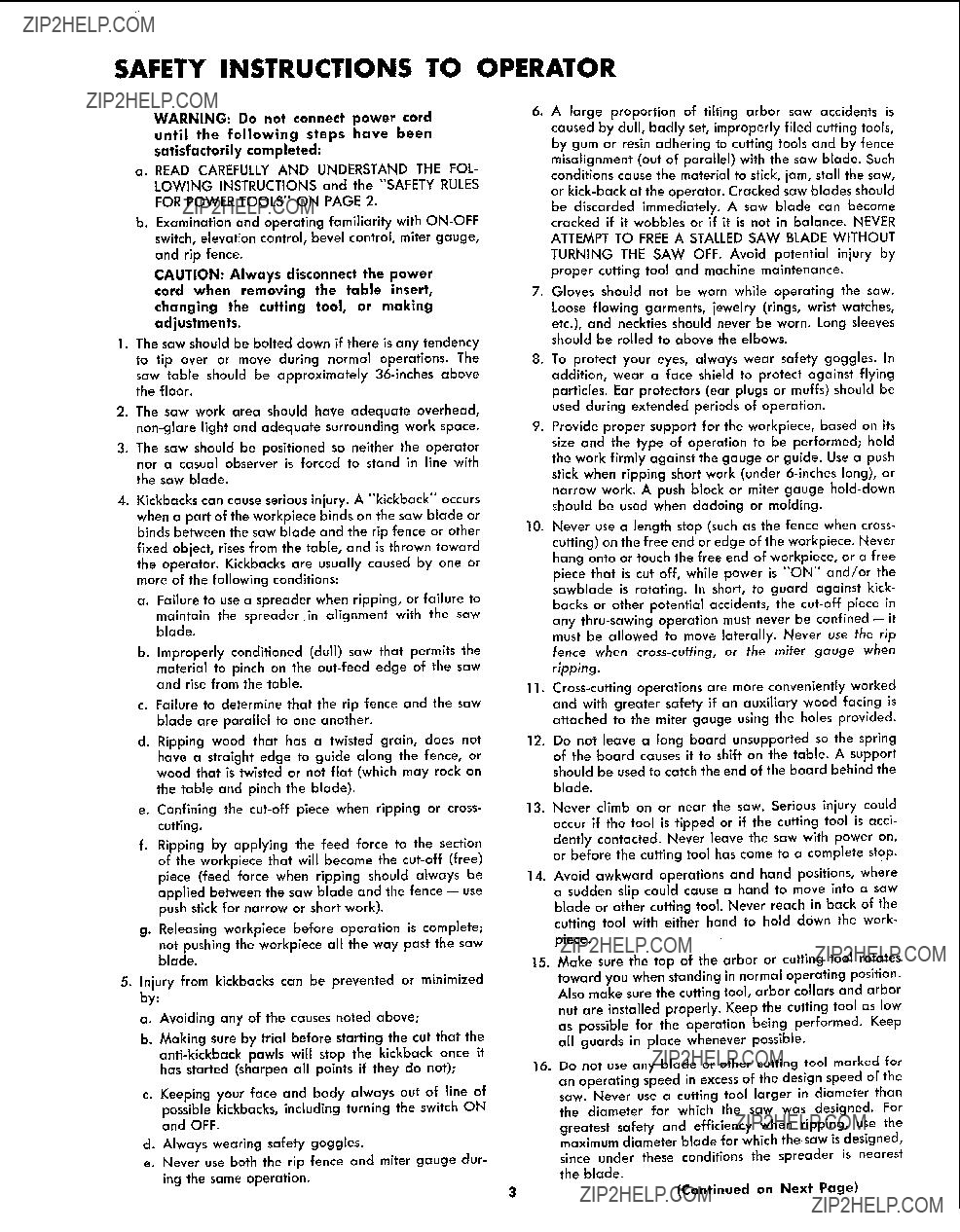
SAFETY INSTRUCTIONS TO OPERATOR
WARNING: Do not connect power cord until the following steps have been satisfactorily completed:
a.READ CAREFULLY AND UNDERSTAND THE FOL- LOWING INSTRUCTIONS and the "SAFETY RULES
FOR POWER TOOLS" ON PAGE 2.
b.Examination and operating familiarity with
CAUTION: Always disconnect the power cord when removing the table insert, changing the cutting tool, or making adjustments.
1.The saw should be bolted down if there is any tendency to tip over or move during normal operations. The saw table should be approximately
2.The saw work area should have adequate overhead,
3.The saw should be positioned so neither the operator nor a casual observer is forced to stand in line with the saw blade.
4.Kickbacks can cause Serious injury. A "kickback" occurs when a part of the workplece binds on the saw blade or binds between the saw blade and the rip fence or other fixed object, rises from the table, and is thrown toward the operator. Kickbacks are usually caused by one or more of the following conditions:
a.Failure to use a spreader when ripping, or failure to maintain the spreader.in alignment with the saw blade.
b.Improperly conditioned (dull) saw that permits the material to pinch on the
c.Failure to determine that the rip fence and the saw blade are parallel to one another.
d.Ripping wood that has a twisted grain, does not have a straight edge to guide along the fence, or wood that is twisted or not flat (which may rock on the table and pinch the blade).
e.Confining the
f.Ripping by applying the feed force to the section of the workplece that will become the
g.Releasing workplece before operation is complete; not pushing the workpiece all the way past the saw blade.
5.Injury from kickbacks can be prevented or minimized by:
a.Avoiding any of the causes noted above;
b.Making sure by trial before starting the cut that the
c.Keeping your face and body always out of line of possible kickbacks, including turning the switch ON and OFF.
d.Always wearing safety goggles.
e.Never use both the rip fence and miter gauge dur- ing the same operation.
6.A large proportion of tilting arbor saw accidents is caused by dull, badly set, improperly filed cutting tools, by gum or resin adhering to cutting tools and by fence misallgnment (out of parallel) with the saw blade. Such conditions cause the material to stick, jam, stall the saw, or
ATTEMPT TO FREEA STALLED SAW BLADE WITHOUT TURNING THE SAW OFF. Avoid potential injury by proper cutting tool and machine maintenance.
7.Gloves should not be worn while operating the saw. Loose flowing garments, jewelry (rings, wrist watches, etc.), and neckties should never be worn. Long sleeves should be rolled to above the elbows.
8.To protect your eyes, always wear safety goggles. In addition, wear a face shield to protect against flying particles. Ear protectors (ear plugs or muffs) should be used during extended periods of operation.
9.Provide proper support for the workpiece, based on its size and the type of operation to be performed; hold the work firmly against the gauge or guide. Use a push stick when ripping short work (under
10.Never use a length stop (such as the fence when cross- cutting) on the free end or edge of the workpiece. Never hang onto or touch the free end of workpiece, or a free piece that is cut off, while power is "ON" and/or the sawblade is rotating. In short, to guard against kick- backs or other potential accidents, the
11.
12.Do not leave a long board unsupported so the spring of the board causes it to shift on the table. A support should be used to catch the end of the board behind the blade.
13.Never climb on or near the saw. Serious injury could occur if the tool is tipped or if the cutting tool is acci-
dently contacted. Never leave the saw with power on, or before the cutting tool has come to a complete stop.
14.Avoid awkward operations and hand positions, where
a sudden slip could cause a hand to move into a saw blade or other cutting tool. Never reach in back of the cutting tool with either hand to hold down the work-
piece.
15.Make sure the top of the arbor or cutting tool rotates
toward you when standing in normal operating position. Also make sure the cutting tool, arbor collars and arbor
nut are installed properly. Keep the cutting tool as low as possible for the operation being performed. Keep all guards in place whenever possible.
16.Do not use any blade or other cutting tool marked for an operating speed in excess of the design speed of the saw. Never use a cutting tool larger in diameter than the diameter for which the saw was designed. For
greatest safety and efficiency when ripping, use the maximum diameter blade for which thesaw is designed,
since under these conditions the spreader is nearest the blade.
(Continued on Next Page)
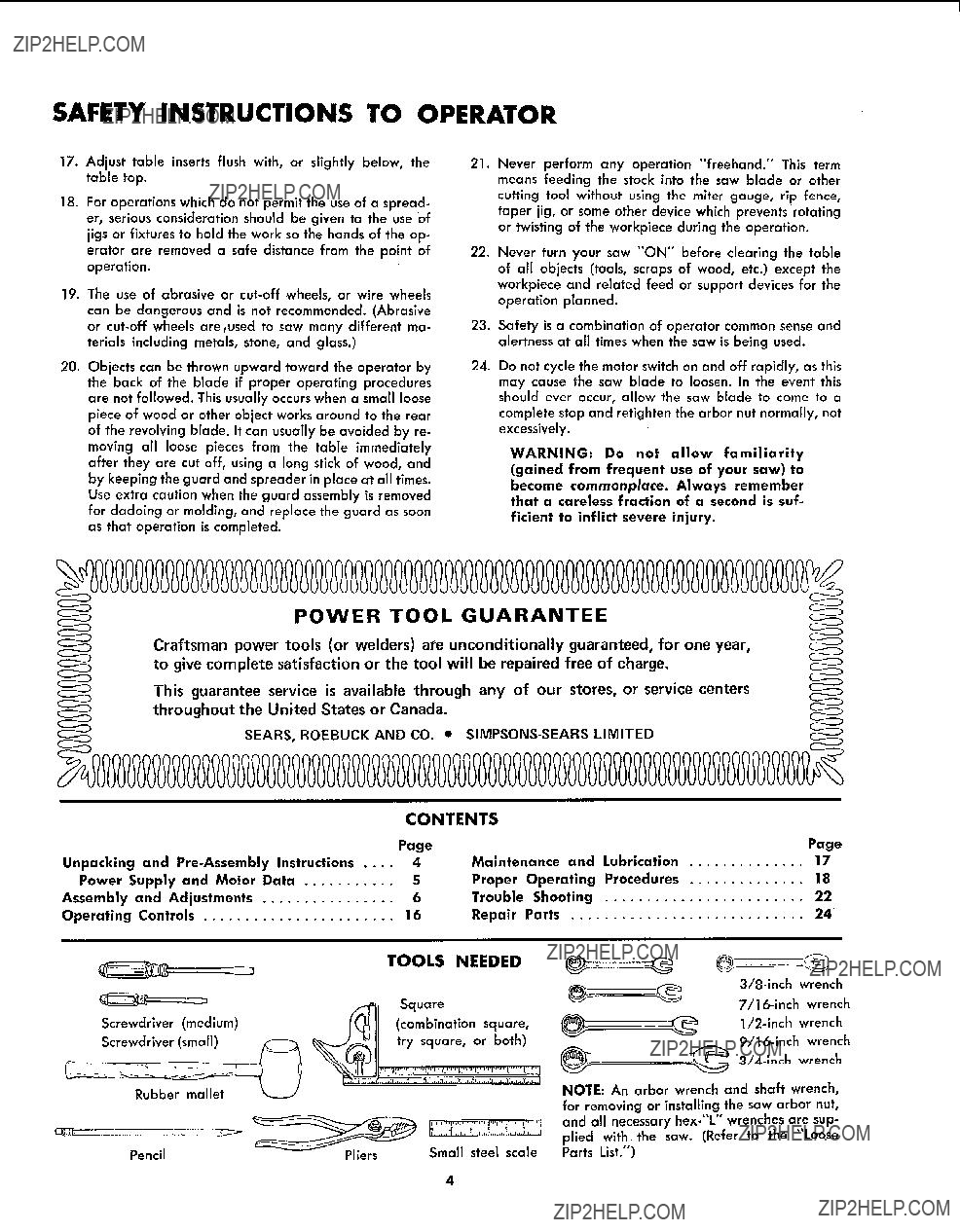
SAFETY INSTRUCTIONS TO OPERATOR
17.Adjust table inserts flush with, or slightly below, the table top.
18.For operations which do not permit the use of a spread- er, serious consideration should be given to the use of
jigs or fixtures to hold the work so the hands of the op- erator are removed a safe distance from the point of operation.
19.The use of abrasive or
20.Objects can be thrown upward toward the operator by the back of the blade if proper operating procedures are not followed. ?his usually occurs when a small loose piece of wood or other object works around to the rear of the revolving blade. It can usually be avoided by re- moving all loose pieces from the table immediately after they are cut off, using a long stick of wood, and by keeping the guard and spreader in place at all times. Use extra caution when the guard assembly is removed for dadoing or molding, and replace the guard as soon as that operation is completed.
21.Never perform any operation "freehand." This term means feeding the stock into the saw blade or other
cutting tool without using the miter gauge, rip fence, taper jig, or some other device which prevents rotating or twisting of the workpiece during the operation.
22.Never turn your saw "ON" before clearing the table of all objects (tools, scraps of wood, etc.) except the workpiece and related feed or support devices for the operation planned.
23.Safety is a combination of operator common sense and alertness at all times when the saw is being used.
24.Do not cycle the motor switch on and off rapidly, as this may cause the saw blade to loosen. In the event this should ever occur, allow the saw blade to come to a complete stop and retighten the arbor nut normally, not excessively.
WARNING: Do not allow familiarity
(gained from frequent use of your saw) to
become commonplace. Always remember that a careless fraction of a second is suf-
ficient to inflict severe injury.
CONTENTS
Screwdriver (medium)
Screwdriver (small)
Pencil
TOOLS NEEDED
_ Square
I_ ]J (combination square,
NOTE: An arbor wrench and shaft wrench, for removing or installing the saw arbor nut, and all necessary
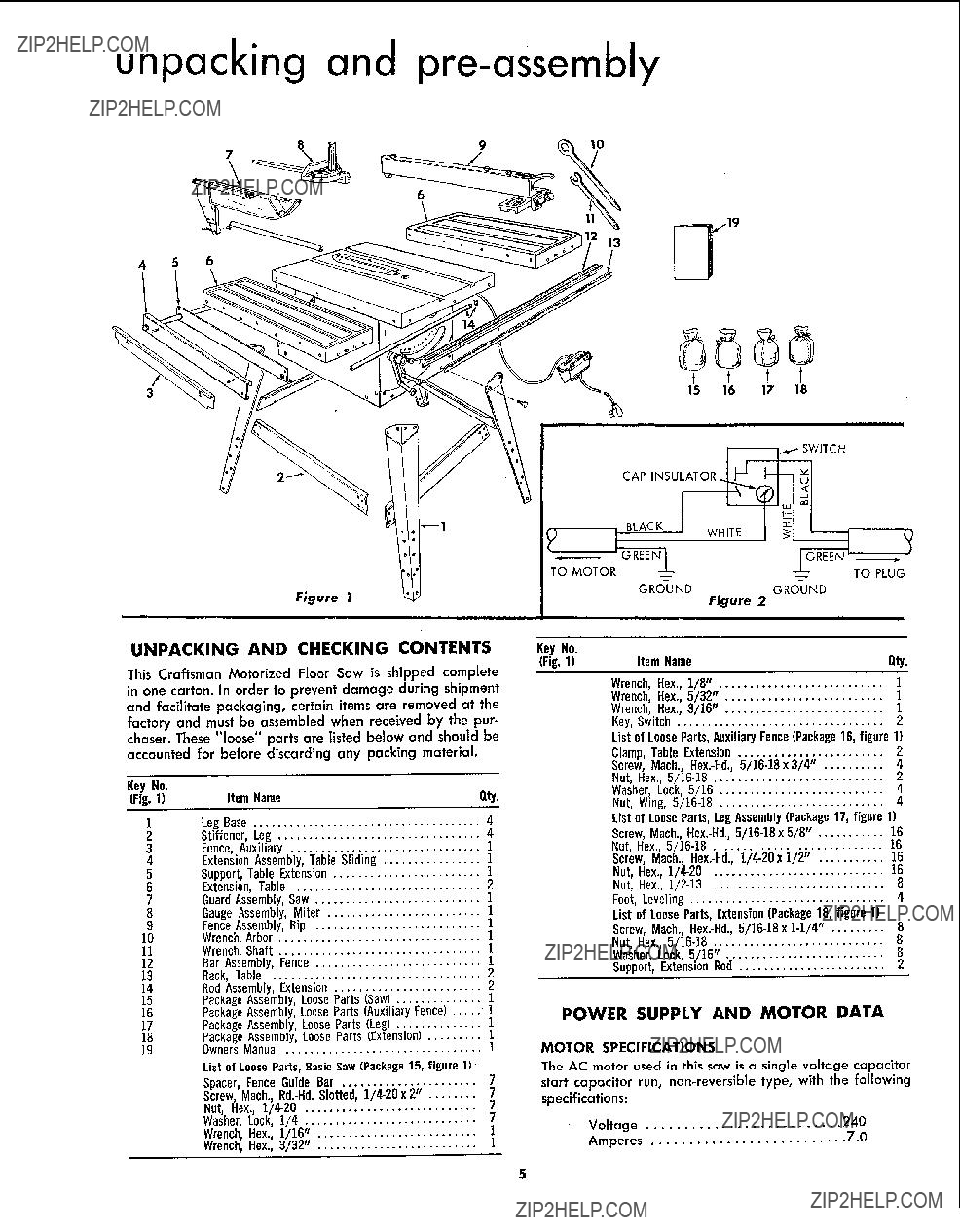
unpacking and
4 S 6
t t t t
15 16 17 18
Figure 1
UNPACKING AND CHECKING CONTENTS
This Craftsman Motorized Floor Saw is shipped complete in one carton. In order to prevent damage during shipment and facilitate packaging, certain items are removed at the factory and must be assembled when receiyed by the pur- chaser. These "loose" parts are listed below and should be accounted for before discarding any packing material.
POWER SUPPLY AND MOTOR DATA
MOTOR SPECIFICATIONS
The AC motor used in this saw is a single voltage capacitor start capacitor run,

assembly and adjustments
CAUTION: This saw is wired for operation on 240 volts only. Connect to a 15 ampere
branch circuit protected by a 15 ampere time delay or circuit saver fuse or circuit breaker.
WARNING: Do not permit fingers to con- tact the terminals of power or motor plugs when installing or removing the plug to or from a live power source. Hold the plug as shown in figure 3.
MOTOR SAFETY PROTECTION
The saw motor is equipped with a
overload protector, designed to open the power line circuit when the motor temperature exceeds a safe value. (See
figure 4.)
1.If the protector opens the line and stopsthe saw motor,
press the saw switch to the "OFF" position immediately and allow the motor to cool.
2.After cooling to a safe operating temperature, the over-
'EG
LING FOOT
NUTS, HEX.
/ iI
// I''_ _ 3/4x5/16
END STIFFENER
I SIDE STIFFENER
Heavy loads, however, require that voltage at motor terminals be not less than the voltage specified on nameplate.
. Most motor troubles may be traced to loose or incorrect connections, overloading, reduced input voltage (which results when small size wires are used in the supply circuit) or when the supply circuit is extremely long. Always check connections, load and supply circuit when the motor fails to perform satisfactorily. Check wire sizes and lengths with the table in the next paragraph. Re- place or repair damaged or worn cord immediately.
WIRE SIZES
The use of any extension cord will cause some loss of power. To keep this to a minimum and to prevent over- heating and motor
NOTE: For circuits of greater length, the wire size must be increased proportionately in order to deliver ample voltage to the saw motor.
load protector can be closed manually by pushing in the red button on the motor terminal box cover. If the red
button will not snap into place immediately, the motor is still too hot and must be allowed to cool for a while
longer.
3.As soon as the red button will snap into running position, the saw may be started and operated normally by pulling the saw switch to the "'ON" position.
4.Frequent opening of fuses or circuit breakers may result if motor is overloaded, or if the motor circuit is fused with a fuse other than those recommended. Do not use
a fuse of greater capacity without consulting the power company.
5.Although the motor is designed for operation on the
voltage and frequency specified on motor nameplate, normal loads will be handled safely on voltages not more than 10% above or below the nameplate voltage.
ASSEMBLY AND ADJUSTMENTS
1.Remove the "'loose" parts; clean the parts and the basic saw assembly thoroughly. (See figure 1.) Items having a
other parts with a clean, dry cloth.
CAUTION: Before attempting to use the saw, assemble it as outlined in the follow-
ing instructions. All adjustments are care- fully checked prior to shipping the saw. However_ rough handling in transit may necessitate some readjustments.
2.Assemble the basic saw assembly and check all ad- justments as outlined in the following instructions:
a. Installation of Legs.
(1)With saw upside down, install legs and leg stif-
6

J
EXTENSION ROD
SUPPORTS
FENCE GUID_ BAR
RACK
SWITCH
BOX
SCREW
Figure 9
feners. (See figure 5.) Using parts from the correct loose parts bag, assemble the legs to the saw base with the sixteen
loose in order to facilitate mounting the stiffeners. All four leg stiffeners are identical and since the distance on the sides is greater than the distance
on the ends, the leg stiffeners used on the sides should be attached at outer holes while the stiffeners at the ends should be attached at inner
holes. (See figure 6.)
(2)Assemble the four stiffeners with sixteen 1/4- 20 x 1/2 inch screws and
stiffeners are all in place, tighten all screws
securely. Install leveling feet, each with 2
(3)Place the saw in an upright position on its legs.
b.Installation of Side Extensions.
(1)Install table extensions on each side of the table with four
extension (See figure 7.) These extensions are provided with multiple holes on both sides (front and back) to make them adaptable to various
Figure 10
ii
table mountings. Position the extensions to the sides of the table so the four holes in the table
and the extensions are aligned when the table and extensions are correctly mated. An extension
rod support should be located under each end screw at
7 and 8.) Leave screws snug (not tight). Be sure to position the extension rod supports as shown in figure 8.
(2) Place a small steel scale across saw table edge and table extensions edge and, using the rubber
mallet, tap extensions slightly up or down (or forward and rearward) until the surface of each table extension is even with surface of table top
and front edge of table. (See figure 9.) Tighten nuts on all attaching bolts securely and recheck
to make sure tightening nuts did not permit ex- tension to move.
c.Installation of fence guide bar, rack and switch box support. (See figure 10.)
(1) Insert a
a spacer. The guide bar should be positioned so the scale faces upward, and is readable from the front of the saw. (See figure 10.)
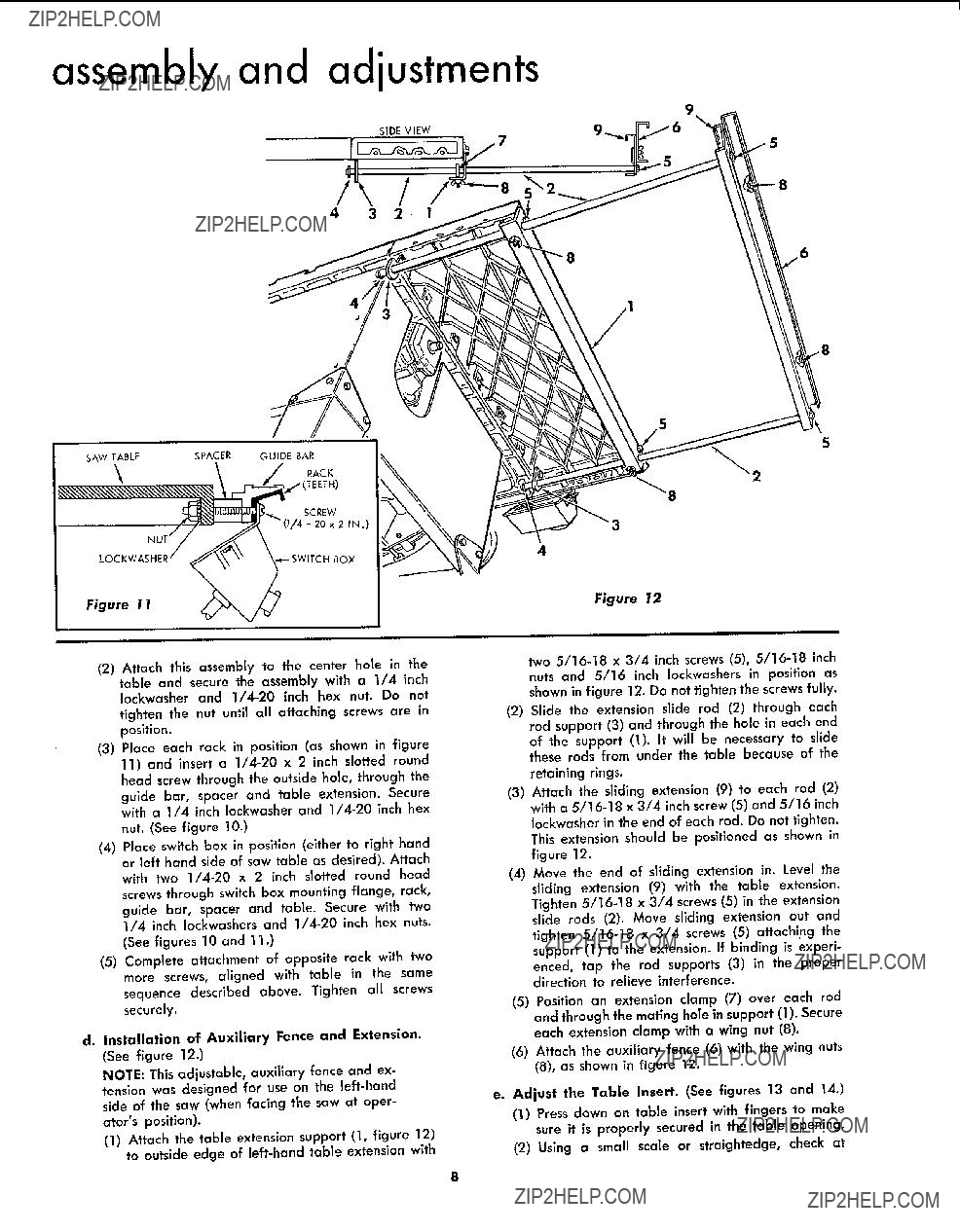
assembly and adiustments
SIDE VIEW
4 3 2 1
4 /
SAW TABLESPACER GUIDE BAR
RACK
Figure 11
(2) Attach this assembly to the center hole in the table and secure the assembly with a 1/4 inch Iockwasher and
tighten the nut until all attaching screws are in position.
(3)Place each rack in position (as shown in figure
11)and insert a
guide bar, spacer and table extension. Secure with a 1/4 inch Iockwasher and
nut. (See figure 10.)
(4)Place switch box in position (either to right hand or left hand side of saw table as desired). Attach with two
screws through switch box mounting flange, rack, guide bar, spacer and table. Secure with two 1/4 inch Iockwashers and
(5)Complete attachment of opposlte rack with two more screws, aligned with table in the same
sequence described above. Tighten all screws securely.
d.Installation of Auxiliary Fence and Extension. (See figure 12.)
NOTE: This adjustable, auxiliary fence and ex- tension was designed for use on the
(1)Attach the table extension support (1, figure 12) to outside edge of
5
4
Figure 12
two
(2)Slide the extension slide rod (2) through each rod support (3) and through the hole in each end
of the support (I). It will be necessary to slide these rods from under the table because of the
retaining rings.
(3)Attach the sliding extension (9) to each rod (2) with a
Iockwasher in the end of each rod. Do not tighten. This extension should be positioned as shown in figure 12.
(4)Move the end of sliding extension in. Level the sliding extension (9) with the table extension. Tighten
(5)Position an extension clamp (7) over each rod and through the mating hole in support (1). Secure each extension clamp with a wing nut (8).
(6)Attach the auxiliary fence (6) with the wing nuts (8), as shown in figure 12.
e.Adjust the Table Insert. (See figures 13 and 14.)
(1)Press down on table insertwith fingers to make sure it is properly secured in the table opening.
(2)Using a small scale or straightedge, check at

each of the four set screw positions to determine if the table insert is even with saw table surface.
(See figure 13.) If uneveness exists, adjust as follows:
(a)If an adjustment is necessary, rotate each of the four set screws (or as many as required) with a 3/32 inch
(b)Make sure that ends of all four set screws are making contact with table recess by pressing on the insert at each set screw location. If the
insert "rocks" when pressed at any of the four screw locations, adjust set screws until
the "'rocking" is eliminated.
3.Adjust the 90 ?? and 45 ?? Stops.
a. Checking and Adjusting the 0 ?? Position
(1)Loosen the elevation lock by pulling out the elevation lock knob and rotate the elevation crank
to raise the saw blade to the deepest cut position.
(See figure 15.) Push elevation lock in.
(2)Loosen the clamp knob and rotate the tilt crank counterclockwise until it will rotate no farther.
(3)With the saw blade in position described above,
tighten the clamp knob to secure the tilt mech- anism.
(4)Place a square on the saw table and against saw blade. (See figure 16.) The blade should be at 90
degrees (perpendicular) to the table top surface.
(5)If the blade is not square with the table top, loosen
the clamp knob (figure 15) and rotate the tilt crank to move the mechanism off the 90 ?? stop. This can be accomplished by rotating the tilt crank until the pointer on tilt scale indicates approxi- mately 10 degrees. Rotate the 90 ?? stop screw in table top with a
FLEVATIOI_KNOB
CRANK
TILT CRANK-
.OCK KNOB
Figure 15
Figure 16
/
STOPSCREW 45??
STOPSCRE_
Figure 17
(6)When the saw blade is adjusted squarely with the table top, check the pointer on the tilt gauge, which should be positioned at exactly "0" (zero) degrees. (See figure 15.) If not at zero, loosen the attaching screw and align pointer with the "0" mark, then tighten the screw.

assembly and adjustments
ARBOR WRENCH
\
COMBINATION SQUARI
ELEVATION
REAR OF SAW
(1)Loosen the clamp knob and rotate the tilt crank clockwise until it will turn no farther. Tighten the clamp knob. At this point, the acute angle made between the saw blade and table top should be 45 degrees. (See figure 18.) The base of a com- bination square (or protractor) can be used effec- tively for this measurement.
(2)If the angle between the saw blade and table top is not 45 ??, loosen the clamp knob and rotate the tilt crank counterclockwise until the pointer on tilt gauge indicates approximately 40 ?? . Rotate the 45 ?? stop screw in table top with a
NOTE: If the above adjustments have been 'per- formed accurately, the saw will now have a positive stop at "'0" (90 ?? position) and "45" degrees. The pointer on the tilt scale should indicate both positions accurately.
4.Aligning Saw Blade With Table Top.
a. Remove the table insert and check the saw arbor
nut to make sure it is tight. Use the shaft wrench on arbor flats and arbor wrench on the arbor nut, as
shown in figure 19. Install the table insert.
the elevating mechanism and, using the elevation crank, position the saw blade for the deepest cut in preparation for aligning the saw blade with table grooves. Push in on the elevation lock knob.
c.Loosenthe clamp knob, and rotate the tilt crank clock- wise until it stops(pointer at 0??). (See figure 20.) This will position the saw blade vertically. Tighten the clamp knob.
d.Make a pencil mark on the saw tooth that is just above the table top at rear of the blade. (See figure 21.)
e.Place the miter gauge in the table groove at left of saw blade. Make sure the miter gauge is set at "0".
f.Lay a
g.Slide the miter gauge to a position which will point the pencil at the marked saw tooth. Hold a small scale against the marked tooth and slide the pencil
toward the saw until the point rests against the scale. With the left thumb, hold the pencil securely in the
miter gauge head. It must not move.
h.With the right hand, remove the scale and rotate the saw blade until the marked tooth is just above the saw table at the front. (See figure 22.)
i.Slide the miter gauge toward the front of saw table until the pencil is pointing toward the marked tooth.
10

Insert the scale between the pencil point and blade, as shown in figure 22. If the saw is parallel to the table groove, the scale will just "slide" into the gap between the pencil point and blade. If the scale will not enter this gap, or is loose in the check shown in figure 22, an adjustment of the table trunnlons is required. Proceed as follows:
(1)Tighten the clamp knob firmly (figure 20) and loosen the two screws which secure each table
trunnion (front and rear) to the table. (See figure 23.) It will be necessary to reach these screws from underneath the table.
(2)Shift the two trunnlons until the preceding meas- urements are equal and tighten all four trunnion screws. Recheck measurements (figures 21 and
22)to make sure tightening the screws did not alter the setting.
5. Check and Adjust Rip Fence
Your Craftsman Rip Fence has been designed to provide accuracy, reliability and long life. In order for your fence to work properly it is imperative that it be adjusted accurately. The fence is adjusted at the factory, but due to shipping hazards and slight tolerance
check your fence and adjust it (if necessary) as outlined in the instructions that follow:
CAUTION: It is imperative that these in- structions be followed precisely, as an in- correct adjustment could damage the fence and the fence guide bar attached to your
saw.
a.Installation of Rip Fence
(1)Raise the lock handle and position the rip fence (10, figure 1) on the saw table. Do not latch the lock handle.
(2)Slide the rip fence along the guide bar while watching the clearance between lower edge of
fence and table top. If any portion of the fence
(except sliding pad at rear) drags on table top, or if clearance between fence and table top
varies appreciably as the fence is moved, the guide bar must be readjusted. This is accom- plished by loosening the attaching screws (figure
10)and
(3)Check for proper engagement (mesh) of teeth on fence adjusting shaft pinion with the gear teeth on underside of rack. (See figure 24.) The pinion
should be adjusted up or down so that teeth are in full contact lengthwise. This adjustment is made as follows:
(4)Push the fence adjusting knob all the way down and look underneath the rack to determine if
pinion and rack teeth are aligned. (See figure 24.) If the pinion extends too far (or not far enough) loosen the set screw (1, figure 25) with a 1/8 inch
@
Figure 23
inn
Figure 24
2
11

assembly and adjustments
Figure 26
DOWN
TO LOCK
Figure 27
FENCE PAWL
Figure 28
Figure 29
assembly (2) on the pinion shaft to achieve proper alignment. Tighten the set screw (1) with a 1/8 inch
(5)To adjust for correct gear mesh (depth of tooth contact), loosen the set screw (3, figure 25) with a 1/8 inch
(6)Move the rip fence carefully across the central portion of table, by rotating the gear knob, to determine if the teeth engage the rack properly at the center division. The fence should pass over the center division of the rack smoothly. If any binding or resistance is noticed it may be neces- sary to loosen the guide bar attaching screws at one end and at the middle, and shift the rack
enough to properly space the teeth at the center
division. Several trials may be necessary.
b. Checking for Parallelism of Rip Fence with Table Groove.
(1)With the lock handle not latched, slide the fence on the saw table so the front edge of the channel is flush with the side of one of the two miter grooves. (See figure 26.) This can be checked by using your fingers as shown to "feel" for correct alignment. Shift the rear of the fence to the right or left slightly, causing fence not to be squcre with the front edge of the table nor pr_allel to the miter groove.
(2)Push down on the lock handle carefully (do not force) while watching the rear of the fence for its correcting action.
CAUTION: Do not force the lack handle. If
the handle does not lock down readily, an adjustment is
(3)The lock handle should lock in the down position. Do not force the handle, as it is not necessary for the handle to be all the way down to lock the fence. (See figure 27.) The rear of the fence should move to correct itself, and do so parallel (flush) with the miter groove in saw table through- out its full length. Alignment may be checked with the forefingers to determine if the fence is flush with the side of miter groove, as shown in figures 26 and 27.
(4)If the lock handle responded as described above, and the fence aligned itself with the table groove at both ends, the fence is properly adjusted and no further attention is necessary. If not, perform the following adjustment routine.
???. Adjusting the Rip Fence
(1)Remove the fence and turn it over. Then, with a
1/8 inch
12

Figure
(2) Using a 5/32 inch
set screw at the rear of the fence approximately two turns. (See figure 29.) This screw is located in the fence lock just inside the channel as shown.
(3)Place the fence back on saw table and notice that the lock handle offers no resistance at any position.
(4)Push the lock handle down in "locked" position and, using a 1/8 inch
(5)Raise the lock handle, push the fence to one side (off square) at the rear. Then lock the fence with the lock handle, while watching to make sure it
"'corrects" itself. Repeat this operation two or more times. The fence should "'correct'" itself each time it is locked.
(6)Raise the lock handle and align the fence with the miter groove (at the front end of the groove) as shown in figure 26. Push the lock handle down.
(7)Check for correct alignment with saw table groove for the full length of the fence. If it is aligned at the front but out of alignment at the rear, loosen the two
(8)Check for "automatic correcting" by releasing the lock lever, shifting the fence off square at the rear, then locking it. The fence should square
itself automatically and be flush (parallel) with
the miter groove each time the handle is locked down.
(9) Lock the fence with the lock handle, using a 5/32 inch
SCALE
(WITH MIRROR SURFACE)
WINDOW
REFLECTED IMAGE
29.) Check to see if rear of fence is "secure" to the table at the rear.
NOTE: If the fence fails to square itself every-
time, check for any burr or foreign material on the surface of the fence head where it contacts
the saw table. Also check for nicks or burrs in
edges of saw table. Stone off any irregularities on these surfaces.
(10)After adjusting the fence on the saw table, move it to one of the table extensions and
adjustment, as even the slightest difference in length between the extensions and saw table would affect the fence adjustment to some degree. If one is slightly shorter than the other it would be evidenced by a lighter "feel" of the fence lever when locking it. If a difference in "feel" is apparent, readjust the fence on the shorter mem- ber and it will, in turn, lock effectively on the longer member.
d.Aligning Rip Fence Plastic Indicators
(1)If for any reason the tilt handle has been rotated during preceding operations, loosen the clamp knob (figure 20) and rotate the tilt crank clock- wise until it stops (tilt pointer at "0"). Tighten the clamp knob.
(2)Position the rip fence on the
determines your width of cut. This distance should be measured accurately with a scale.
(3)Set the
the plastic window) to "1" inch on the
(a)A close look will show a reflection of the indicator line on the mirror surface of the
13

assembly and adjustments
INDICATOR LINE
IN PLASTIC WINDOW
a.Checking the Miter Gauge
(1)Loosen the lock handle and push the stop pin firmly into the middle detent ("0'"position on the scale.) The stop pin will be seated more effec- tively if it is rotated slightly as it is being "'pushed'"
Figure 33
SCREWS
into the detent. Tighten the lock handle. (See figure 34.)
NOTE: Always tighten the lock handle hand- tight only. Do not use a wrench on the lock handle.
(2) Using a combination square, check for an exact
LOCK HANDLE
STOP
PIN
SQUARE
Figure 34
(b) If an adjustment is required, loosen the two screws (one at each end of the window) and
shift the plastic window until the indicator line is aligned with the "'1" inch line on the scale. (See figure 33.) Tighten the two screws and recheck for accuracy. If the plastic window cannot be shifted enough to provide this align- merit, loosen the screws that secure the guide- bar scale to the
proceed to adjust the plastic window as de- scribed above.
(c)When the fence is correctly adjusted and moved to any position at the right of the saw blade, the scale will indicate the width of the desired cut. Make several trial settings and
check by measuring with a scale from the fence to the blade.
NOTE: When properly adjusted, the indicators may be used for most operations, thus elim- inating the need for actual measurements except for extreme requirements. When sighting the indicator, always use the system shown in figure 32 in order to make sure the sight angle is correct.
(d)Move the fence to the
NOTE: Remember, if the
6. Check and Adjust the Miter Gauge
NOTE: This gauge was set correctly at the fac- tory, but rough handling during shipping might have disturbed the setting. To assure maximum
accuracy the "0 ????(zero) degree stop should be checked and adjusted (if required) as follows:
b.Adjusting the Miter Gauge
(1)Loosen the lock handle, disengage stop pin, hold
the square solidly against the rod assembly and face, then tighten the lock handle firmly by hand.
Recheck to make sure that tightening the lock handle did not alter the setting. Remove the square from the gauge.
(2)Loosen the two screws that attach the indicator block to the rod assembly. Shift the indicator block until the stop pin can be pushed solidly into its detent. Hold the indicator block aligned with
the rod assembly and the stop pin seated firmly in the detent and tighten the two screws.
(3)Loosen the lock handle and recheck for accuracy with the square. (Make certain the stop pin is fully seated.) Tighten the lock handle and readjust if necessary.
(4)After completing the above adjustment, loosen the pointer attaching screw, set pointer at "0" (zero) and tighten the screw.
NOTE: Detents at the two
7.Install and Adjust the Saw Guard Assembly.
Position the saw blade for deepest cut and against the 90 ?? stop, (square with table top).
The guard assembly (8, figure 1) consists of a clear plastic blade guard, spreader and
a.Installatlan af Saw Guard Assembly. (See figures 35 and 36.)
(1)Loosenthe lock handle on spreader support, slide the lower end of the spreader support on the
spreader rod (attached to end of spreader bar). (See figures 35 and 36.)
(2)Push the spreader support onto the spreader rod until the groove in spreader support is snug against the groove pin. Tighten the lock handle. (See figure 36.)
b.Alignment af Saw Guard Assembly. (See figures 35 and 36.)
(1)Raisethe plastic guard up to expose the spreader.
14

(2)Place a square against the spreader and saw table top. (See figure 36.) If the spreader bar is not positioned at 90 ?? with the table, loosen the two clamping screws (figure 35) and rotate the spreader bar until the spreader is square with the table (figure 36.) Tighten the two clamp- ing screws (figure 35) and recheck to make sure tightening the screws did not change the adjust- ment. More than one trial may be required.
(3)Sight along the spreader and saw blade to check'
for alignmenl;. An alternate method is to hold a straightedge against each side of saw blade and notice whether or not the spreader is centered in the gap thus formed between the straightedges.
(4)If the spreader is too far to the right or left, loosen the
(5)Rotate the plastic guard down into operating position.
(6)For safety and to minimize kickbacks, the blade guard and spreader must always be in place for all
always be kept in proper alignment with the saw blade so the spreader doesn't prevent pushing the work past the blade. The blade guard will help to prevent sawdust and splinters from being thrown upward.
(7)To remove the blade guard and spreader, loosen the lock handle and slide it off. Do not disturb
the spreader rod.
CAUTION: Use extra care whenever the blade guard is removed far operations in- cluding Dado and Molding.
8.Adjust the
(See figures 37 and 38.)
The cut indicator
mine precisely where the cut in a particular board will occur, provided the cut indicator shoes have been cor-
rectly positioned. It should be checked and adjusted (if necessary) as follows:
a.Position the saw blade in the 90 ?? position (0 ?? on
tilt scale), by loosening the clamp knob and rotating the tilt crank counterclockwise until it will rotate no
farther. Tighten the clamp knob.
b.With the saw running, place a straight board (pref- erably hardwood) against the miter gauge and hold it securely in the miter gauge.
c.Make a small cut and pull the miter gauge back until
the cut is directly on the
GUARD "_ _,,_ ';AK.wCLKsBAC
SAWTABLE9oo 111"
SPREADER : lib :
ROD SETI _SPREADERSUPPORT
\SCREWl I/
LI SPREA??ERR??D
SPREADER
K.ANOLE
GROOVE PIN -
VIEW FROM REAR OF SAW
Figure 36
WIDTH OF
Figure 38
15

operating controls
OPERATING CONTROLS
Before operating the saw, the operator should examine all controls until thoroughly familiar with their functions, as well as making sure that controls are operating properly.
(See figure 39.)
CAUTION: Under no circumstances should
a blade with a diameter greater than 12 inches be used with this saw.
1. Elevation Crank (li figure 39i. Located on the front panel to control elevation of the saw blade,
2.Elevation Lock (2, figure 39). Located on front panel for securing the saw in desired elevated position. It is pushed in to lock and pulled out to release.
3.Tilt Crank (3, figure 39). Located on front panel be- hind the elevation crank to control the angle of tilt.
The saw blade can be tilted from 0 ?? to 45 ??, as indi- cated on the TILT SCALE (5). If the angle of cut (tilt) must be extremely accurate, the angle of the saw blade should be checked wffh a protractor, or with a board known to be cut at the exact angle required.
4. Clamp Knob (4, figure 39.) Located on front panel to lock the tilt mechanism in any desired position. The tilt
mechanism should always be locked before starffng work and should always be unlocked before attempt-
ing to change the angle of tilt.
5.
the underside of saw table as shown in figure 39. To
turn the switch on, the operator inserts the key (figure 40) and hooks the forefinger of the right hand under the end of switch lever and pulls downward. The switch is turned off by simply pressing upward on the switch lever. When removing the key (figure 41), always hold
the thumb or finger against end of switch lever to pre-
vent the switch from being turned on as the key is re- moved.
6. Rip Fence (1, figure 42). When the lock handle (2,
figure 42) is released (raised), the rip fence (1) may be moved toward, or away from, the saw by hand.
Pushing the lock handle (2) down into locked position will automatically align the rip fence parallel to the table groove. This alignment correction will occur at the front of saw table. Therefore, it may be necessary
to make more than one setting in order to produce the exacf distance desired between saw blade and fence.
Keep the saw table and rip fence clean, as saw dust may prevent the fence from assuming proper align- ment when tightened.
7. Lock Handle (2, figure 42). This handle is used to
clamp the rip fence in place after it has been moved to the desired position. (Refer to preceding step 6.)
8.Fence Knob (3, figure 42). This knob (when depressed) moves a pinion into engagement with the rack teeth to permit accurate positioning of the rip fence.
9.Miter Gauge (4, figure 42). This gauge is used in table grooves as a guide for the
10.Sliding Table Extension (6, figure 42). This extension permits a greatly extended work area and provides an
outboard fence for handling such items as table tops, doors, etc. Loosen wing nut (7) to adjust the extension. Loosen wing nut (8) to raise or lower the auxiliary fence.
11.
commonly called an
1 \
3
2
Figure 42
4
Figure 39
6 8
Figure 40 Figure 41
16
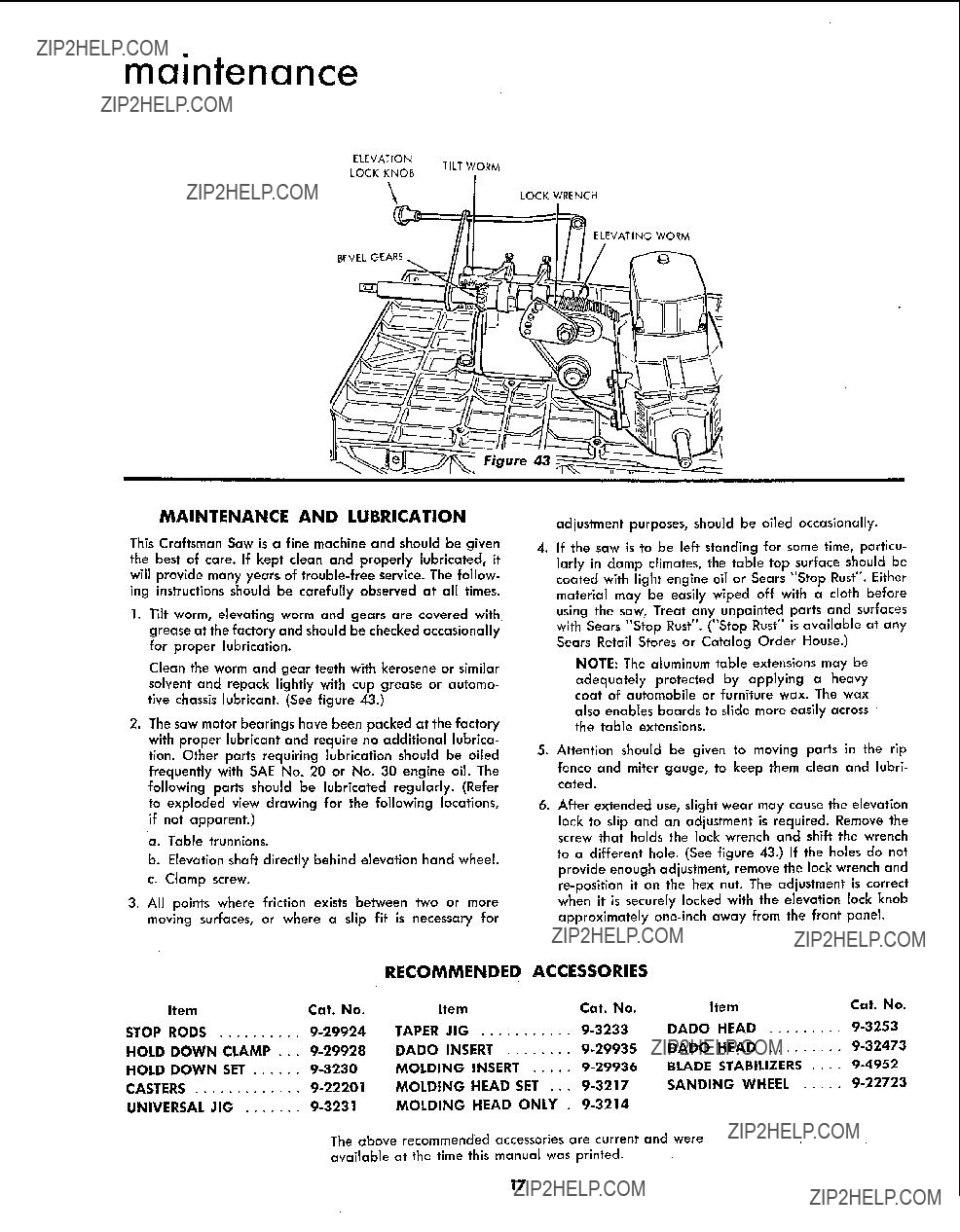
maintenance
ELEVATION
LOCK KNOB
TILT WORM
LOCK WRENCH
MAINTENANCE AND LUBRICATION
This Craftsman Saw is a fine machine and should be given the best of care. If kept clean and properly lubricated, it will provide many years of
1.Tilt worm, elevating worm and gears are covered with. grease at the factory and should be checked occasionally for proper lubrication.
Clean the worm and gear teeth with kerosene or similar solvent and repack lightly with cup grease or automo- tive chassis lubricant. (See figure 43.)
2.The saw motor bearings have been packed at the factory with proper lubricant and require no additional lubrica- tion. Other parts requiring lubrication should be oiled frequently with SAE No. 20 or No. 30 engine oil. The following parts should be lubricated regularly. (Refer to exploded view drawing for the following locations, if not apparent.)
a.Table trunnions.
b.Elevation shaft directly behind elevation hand wheel. c. Clamp screw.
3.All points where friction exists between two or more moving surfaces, or where a slip fit is necessary for
i
adjustment purposes, should be oiled occasionally.
4.If the saw is to be left standing for some time, particu-
larly in damp climates, the table top surface should be coated with light engine oil or Sears "Stop Rust". Either
material may be easily wiped off with a cloth before using the saw. Treat any unpainted parts and surfaces
with Sears "Stop Rust". ("Stop Rust" is available at any Sears Retail Stores or Catalog Order House.)
NOTE: The aluminum table extensions may be
adequately protected by applying a heavy coat of automobile or furniture wax. The wax
also enables boards to slide more easily across the table extensions.
5.Attention should be given to moving parts in the rip
fence and miter gauge, to keep them clean and lubri- cated.
6.After extended use, slight wear may cause the elevation
lock to slip and an adjustment is required. Remove the screw that holds the lock wrench and shift the wrench
to a different hole. (See figure 43.) If the holes do not provide enough adjustment, remove the lock wrench and
RECOMMENDED ACCESSORIES
and were
17

proper operating
DOWN CLAMP
Figure 44
RODS
procedures
CROSSCUTTI NG
CROSSCUTTING is known as cutting wood across the
grain, at 90 ??, or square with both the edge and the flat side of the wood. This is done with the miter gage set at "'0".
The miter gage may be used in either of the grooves in the table. Make sure it is locked.
When using the miter gage in the LEFT hand groove, hold the workpiece firmly against the miter gage head with your left hand, and grip the lock handle with your right ... or use
When using the RIGHT hand groove, hold the workpiece with your right hand and the Iockhandle with your left hand.
REPETITIVE CUTTING
Figure 45
BLOCK
\
Figure 47
REPETITIVE CUTTING is known as cutting a quantity of pieces the same length without having to mark each piece.
Use the Stop Rods (Optional Accessory) for cutting pieces 6 inches long or longer. (See figure 45.)
When making repetitive cuts shorter than 6 inches, DO
NOT USE THE RIP FENCE AS A LENGTH STOP ...
BECAUSE THE CUT OFF PIECE COULD BIND
BETWEEN THE FENCE AND BLADE AND CAUSE A
KICKBACK.
ALWAYS clamp a block of wood at least 2 inches thick and 3 inches long to the table to act as a length stop. (See figure 46.)
1.Slide the workpiece along the miter gage until it touches the block ... hold it securely or clamp it with the
2.Make the cut ... pull the workpiece back ... push the cut off pieces off the table with a long push stick ..,
DO NOT ATTEMPT TO PICK THEM UP AS THIS
COULD ENDANGER YOUR HANDS.
MITER CUTTING
MITER CUTTING is known as cutting wood at an angle
other than 90 ?? with the edge of the wood. Follow the same procedure as you would for crosscutting.
Adjust the miter gage to the desired angle, and lock it.
The miter gage may be used in either of the grooves in the table,
When using the miter gage in the LEFT hand groove, hold the workpiece firmly against the miter gage head with your left hand. nnd grip the leek handle with your right ... or use
When using the RIGHT hand groove, hold the workpiece with your right hand and the Iockhandle with your left hand.
18

BEVELCROSSCUTTING
BEVEL CROSSCUTTING is the same as crosscutting except that the wood is also cut at an angle . ???. other than g0 degrees with the flat side of the wood.
Adjust the blade to the desired angle.
Use the miter gage in the groove to the RIGHT of the blade ???.. NEVER TO THE LEFT. Hold the workpiece with your right hand and the Iockhandle with your left hand ... or use
48).
COMPOUND MITER CUTTING
Compound miter cutting is a combination of miter cutting and bevel crosscutting. The cut is made at an angle other than 90 degrees to both the edg_ and the flat side of the wood.
Adjust the miter gage and the blade to the desired angle
???..make sure miter gage is locked.
Use the miter gagein the groove to the RIGHT of the blade ???.. NEVER TO THE LEFT. Hold the workpiece with your right hand and the Iockhandle with your left hand ... or use
RIPPING, BEVEL RIPPING, RESAWING AND RABBETING (along the edge of a workpiece) are performed using the RIP FENCE together with AUXILIARY deviceswhen required.
WARNING: FOR YOUR OWN SAFETY, ALWAYS
OBSERVE THE FOLLOWING SAFETY PRECAUTIONS.
1.Never make these cuts FREEHAND (without using the rip fence or auxiliary devices when required) because the blade could bind in the cut and cause a
KICKBACK.
2.Always lock the rip fence securely when in use.
3.Remove miter gage from table.
4.Make sure blade guard is installed for all rip type cuts. Replace the guard IMMEDIATELY following completion of resawing, rabbeting, dadoing, or molding operations.
Frequently check the action of the
Pull the workpiece TOWARD you. If the PAWLS do not DIG into the workpiece and HOLD it ... the pawls must be SHARPENED. Refer to "Maintenance" section further on in this manual.
5.Have blade extend approximately 1/8 inch above top of
workpiece. Additional blade exposure could be hazardous.
6.Do not stand directly in front of the blade in case of a KICKBACK. Stand to either side of the blade.
7.Keep your hands clear of the blade and out of the path of the blade.
B.If the blade stalls or stops while cutting, TURN SWITCH OFF before attempting to free the blade.
2X4 HANDLE
Figure 50
g.Do not reach over or behind the blade to pull the workpiece through the cut ... to support long or heavy workpieces ... to remove small
10.Do not pick up small pieces of
11.Do not remove small pieces of
HANDS or cause a KICKBACK.
Turn the saw OFF ... lift the guard and remove the piece.
Certain ripping cuts require the use of Auxiliary Devices.
Learn to know WHEN and HOW to use these devices for NARROW ripping. You can make them from scraps of wood.
PUSH STICK
Make one using a small piece of 1 x 2. (See figure 49.)
AUXILIARY FENCE/PUSH BLOCK
Make one using a piece of 3/8 inch plywood and a small piece of 2 x 4. (See figure 50.)
19

proper operating procedures
ALWAYS SUPPORT
WORKPIECES
Figure 51
WOR K SUPPORT
Use a "saw horse" ,.. and a piece of plywood. (See figure
51.)
When "WIDTH OF RIP" is 6 inches and WIDER use your RIGHT hand to feed the workpiece until it is clear of the table. (See figure 52.)
Use LEFT hand ONLY to guide the workpiece ... do not
FEED the workpiece with the left hand.
When "WIDTH of RIP" is 2 inches to 6 inches wide USE
THE PUSH STICK to feed the work. (See figure 53.)
When WIDTH of RIP is NARROWER than 2 inches, the push stick CANNOT be used because the guard will INTERFERE ... USE the AUXILIARY FENCE/PUSH BLOCK. (See figure 54.)
NARROW RIPPING - SHORT PIECES - UP TO 18"
Position the AUXILIARY FENCE to the desired WIDTH
OF RIP . .. lock RIP FENCE in place.
Hold workpiece against AUXILIARY FENCE ... feed with RIGHT hand ... guide with LEFT hand until clear of table. (See figure 55.)
NARROW RIPPING - LONG PIECES - 18" and
LONGER
Position the AUXILIARY FENCE with handle against the table to the desired WIDTH of RIP ... lock fence in place. (See figure 56.)
Figure 52
I
Figure 55
Figure 53
Figure 54
I
Figure 56
HANDLE AGAINST
TABLE
2O

EvENW'TH,AOLE
Figure 58
Hold workpiece against auxiliary fence and feed with left hand until workpiece is about EVEN with END of table
???..Stop Feeding. (See figure 57.)
Hold workpiece FIRMLY ... turn AUXILIARY FENCE over ... (See figure 58.)
Hold workpiece against AUXILIARY FENCE ... feed with RIGHT Hand ... guide with LEFT hand until clear of table. (See figure 59).
When ripping thin strips that may enter the guard and strike the baffle. CAREFULLY raise guard only enough to clear the workpiece. (See figure 60 and 61.)
RESAWING
RESAWING is known as ripping a piece of wood through its thickness. To RESAW a piece of wood wider than
and use an AUXI LIARY FENCE which you can make.
Do not attempt to resaw BOWED or WARPED material.
Use a piece of 3/8 inch plywood 9 in. x 20 in .... and attach a strip of wood
Clamp it to the table so that the workpiece will SLIDE EASILY but not TILT or MOVE SIDEWAYS without
BIN DI NG between the two fences. (See figure 63.)
WARNING: FOR YOUR OWN SAFETY ...
1.NEVER RESAW FREEHAND (WITHOUT USING RIP
FENCE AND AUXILIARY FENCE) BECAUSE THE
BLADE COULD BIND IN THE CUT AND CAUSE A
KICKBACK???
2??? DO NOT "BACK UP" (REVERSE FEEDING) WHILE RESAWlNG BECAUSE THIS COULD CAUSE A
KICKBACK.
3.INSTALL BLADE GUARD IMMEDIATELY UPON COMPLETION OF THE RESAWlNG OPERATION.
DADOI NG
For best results and to avoid excessive load on the motor, NEVER CUT A 13/16" WIDE DADO, DEEPER THAN 3/4" IN ONE PASS.
Figure 59
BAFFLE
Figure 60
Figure 62
WIDER THAN
Figure. 63
21
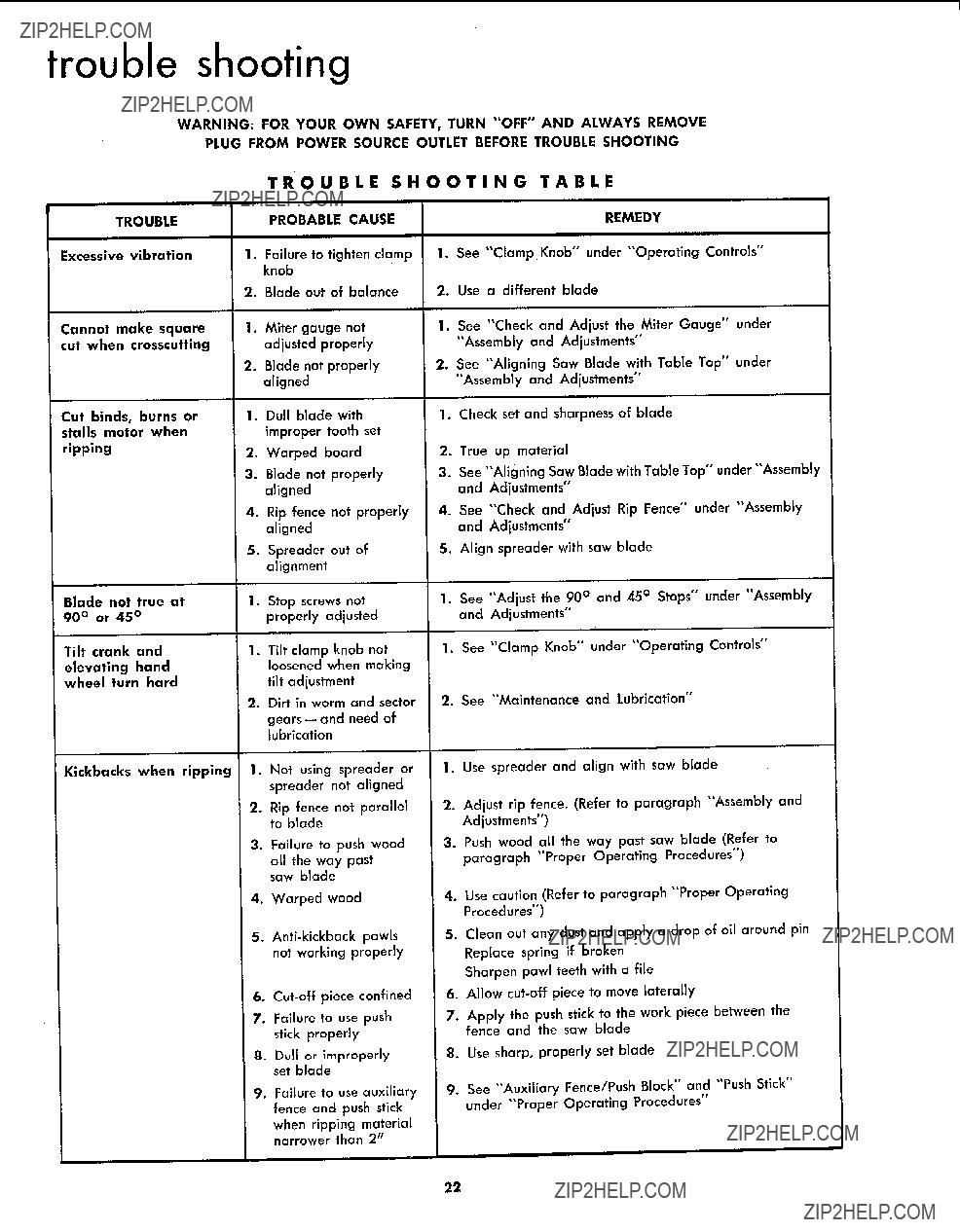
Blade not true at 90 ?? or 45 ??
Tilt crank and
elevating hand wheel turn hard
1.Stop screws not properly adjusted
1.Tilt clamp knob not loosened when making tilt adjustment
2.Dirt in worm and sector
1.See "Adjust the 90 ?? and 45 ?? Stops" under "Assembly and Adjustments"
1.See "Clamp Knob" under "Operating Controls"
2.See "Maintenance and Lubrication"
lubrication
Kickbacks when ripping 1. Not using spreader or
spreader not aligned
2. Rip fence not parallel to blade
3. Failure to push wood all the way past
saw blade
1.Use spreader and align with saw blade
2.Adjust rip fence. (Refer to paragraph "Assembly and
Adjustments")
3.Push wood all the way past saw blade (Refer to paragraph "Proper Operating Procedures")
4.Warped wood
5.
6.
7.Failure to use push stick properly
g.Dull or ;rnproperly set blade
9.Failure to use auxiliary fence and push stick when ripping material narrower than 2"
4.Use caution (Refer to paragraph "Proper Operating
Procedures")
S.Clean out any dust and apply a drop of oil around pin Replace spring if broken
Sharpen pawl teeth with a file
6.Allow
7.Apply the push stick to the work piece between the fence and the saw blade
8.Use sharp, properly set blade
9.See "'Auxiliary Fence/Push :Block" and "Push Stick" under "'Proper Operating Procedures"
22

The following table lists some of the most common troubles caused by low voltage, their causes and suggested remedies:
NOTE: Motors used on
are particularly susceptible to the accumu- lation of sawdust and wood chips and should
be blown out or "'vacuumed" frequently to prevent interference with normal motor ventilation.
REMEDY
Motor fails to develop full power. (Power output of motor decreases rapidly with decrease in voltage at motor terminals.) For example: a reduction of 10% in voltage causes a reduction of 19% in maximum power output of
which the motor iscapable, while a reduction of 20%
in voltage causes a reduction of 36% in maxi-
mum power output.
1.Power line overloaded with
lights, appliances and other motors.
2.Undersize wires or circuit too long.
g.General overloading of power company's facilities. (In many sections of thecountry, demand
for electrical power exceeds the capacity of existing generating and distribution systems.)
1.Reduce line load.
2.Increase wire sizes, or reduce length of wiring.
3.Request a voltage check from the power company.
2.Improper cooling. (Air circulation restricted through motor clue to sawdust, etc.)
1.Correct low voltage condition.
2.Have relay replaced.
1.Correct overload condition.
2.Clean out sawdust to provide normal air circulation through motor.
Starting relay in motor will not operate.
1.Burned relay contacts (due to extended
2.Open relay coil.
3.Loose or broken connections in motor terminal box.
1.Have relay replaced.
2.Have relay replaced.
3.Have wiring checked and repaired.
Motor stalls (resulting in 1. Starting relay not operating.
blown fuses or tripped 2. Voltage too low to permit circuit breakers).motor to reach operating
speed.
3.Fuses or circuit breakers do not have sufficient capacity.
3.Starting relay not operating (motor does not reach normal speed).
1.Have relay replaced.
2.Request voltage check from power company.
3.Replace fuses or circuit breakers with proper capacity units.
1.Reduce motor load.
_.. Replace _uses or circuit breakers.
3. Have relay replaced.
23

PARTS LIST FOR CRAFTSMAN
DETAIL A
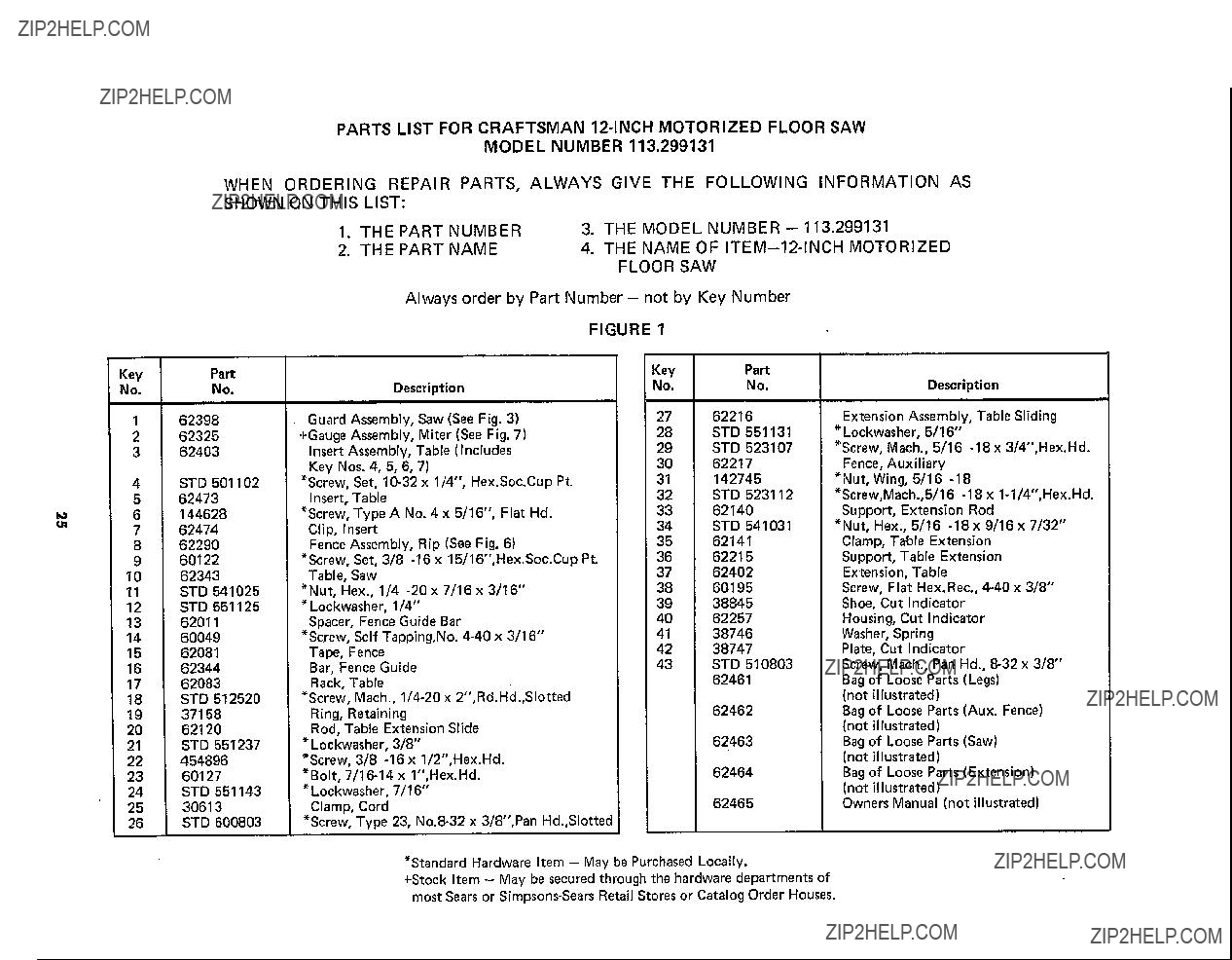
PARTS LIST FOR CRAFTSMAN
MODEL NUMBER 113.299131
WHEN ORDERING REPAIR PARTS, ALWAYS GIVE THE FOLLOWING INFORMATION AS
SHOWN ON THIS LIST:
Always order by Part Number - not by Key Number
FIGURE 1
262325+Gauge Assembly, Miter (See Fig. 7)
362403Insert Assembly, Table (Includes
862290Fence Assembly, Rip (See Fig. 6)
960122*Screw, Set, 3/8
1362011Spacer, Fence Guide Bar
1460049*Screw, Self Tapping,No.
22454896*Screw, 3/8
2360127*Bolt,
2762216
28STD 551131
29STD 523107
3062217
31142745
32STD 523112
3362140
34STD 541031
3562141
3662215
3762402
3860195
3938845
4062257
4138746
42 38747
43STD 51 0803
62461
62462
62463
62464
62465
Description
Extension Assembly, Table Sliding * Lockwasher, 5/16"
*Screw, Mach., 5/16
*Nut, Wing, 5/16
*Screw, Mach.,5/16
*Nut, Hex., 5/16
Support, Table Extension Extension, Table
Screw, Flat Hex.Rec.,
Housing, Cut Indicator Washer, Spring
Plate, Cut Indicator
Screw, Mach., Pan Hd.,
(not illustrated)
Bag of Loose Parts (Aux. Fence) (not illustrated)
Bag of Loose Parts (Saw) (not illustrated)
Bag of Loose Parts (Extension) (not illustrated)
Owners Manual (not illustrated)
*Standard Hardware Item - May be Purchased Locally.
+Stock Item - May be secured through the hardware departments of most Sears or
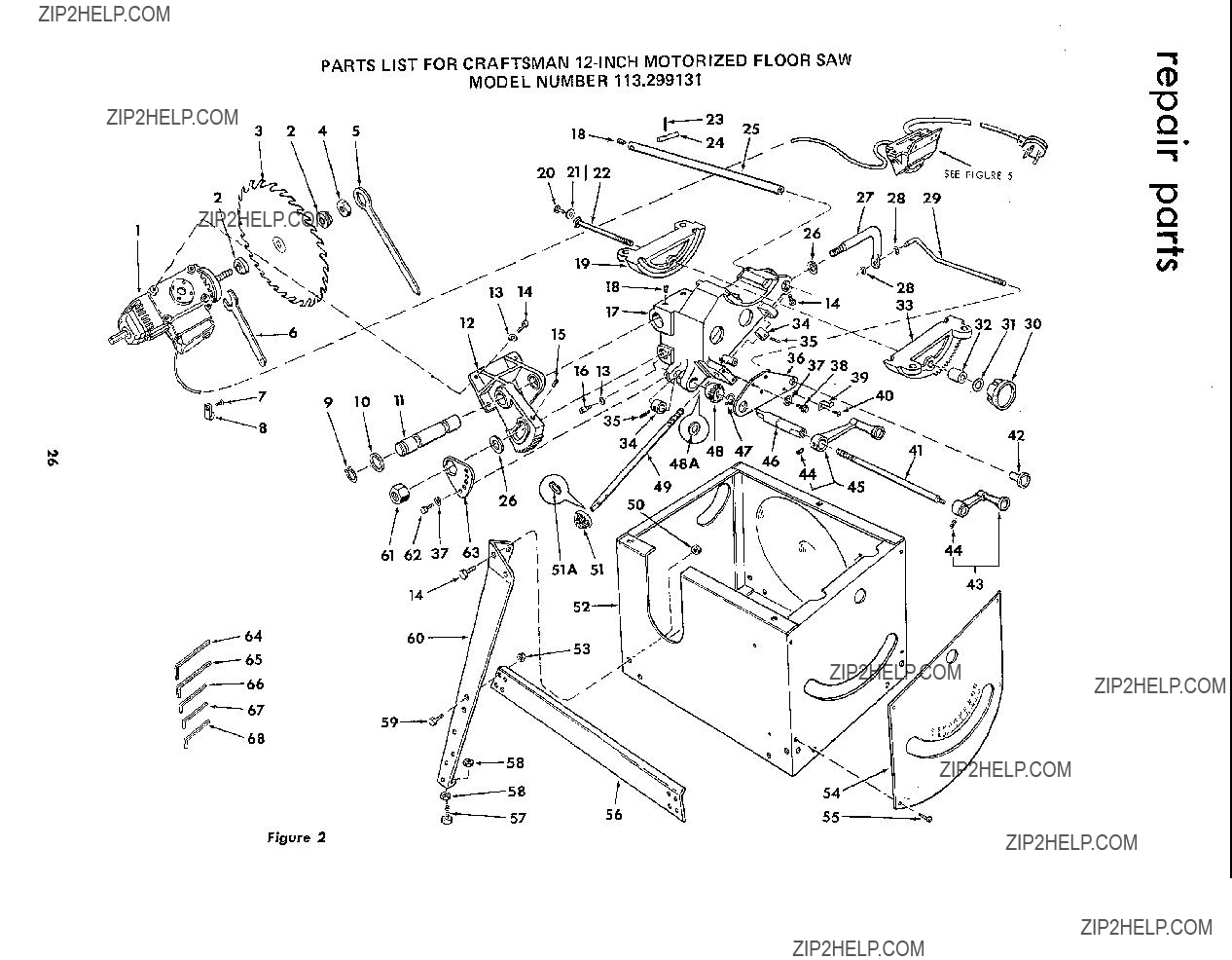
PARTS LIST FOR CRAFTSMAN
MODEL NUMBER 113.299131
3 2 4
9 10 11
48 47
48A
49
5O
61 62 37 63
51A 51
64
65
"0
Q
m ???
Figure 2

1 62459
230494
360177
46362
5 3540
663062
7STD 600803
830613
962341
1062342
1162340
1262339
13STD 551131
14STD 523106
15STD 503705
1662093
1762330
18STD 503103
1962098
20STD 601103
21STD 551012 22 62100
23 STD 571812
24 62111
2562218
26STD 551050
2762094
2838825
2962O97
3062331
3163011
3262101
3362099
3462086
35STD 571810
3662090
37STD 551125

repair parts
PARTS LIST FOR CRAFTSMAN
MODEL NUMBER 113.299131
4 5 1
2
6
8
8
FIGURE 3 - 62398 GUARD ASSEMBLY
*Standard Hardware Item - May be Purchased Locally.
28
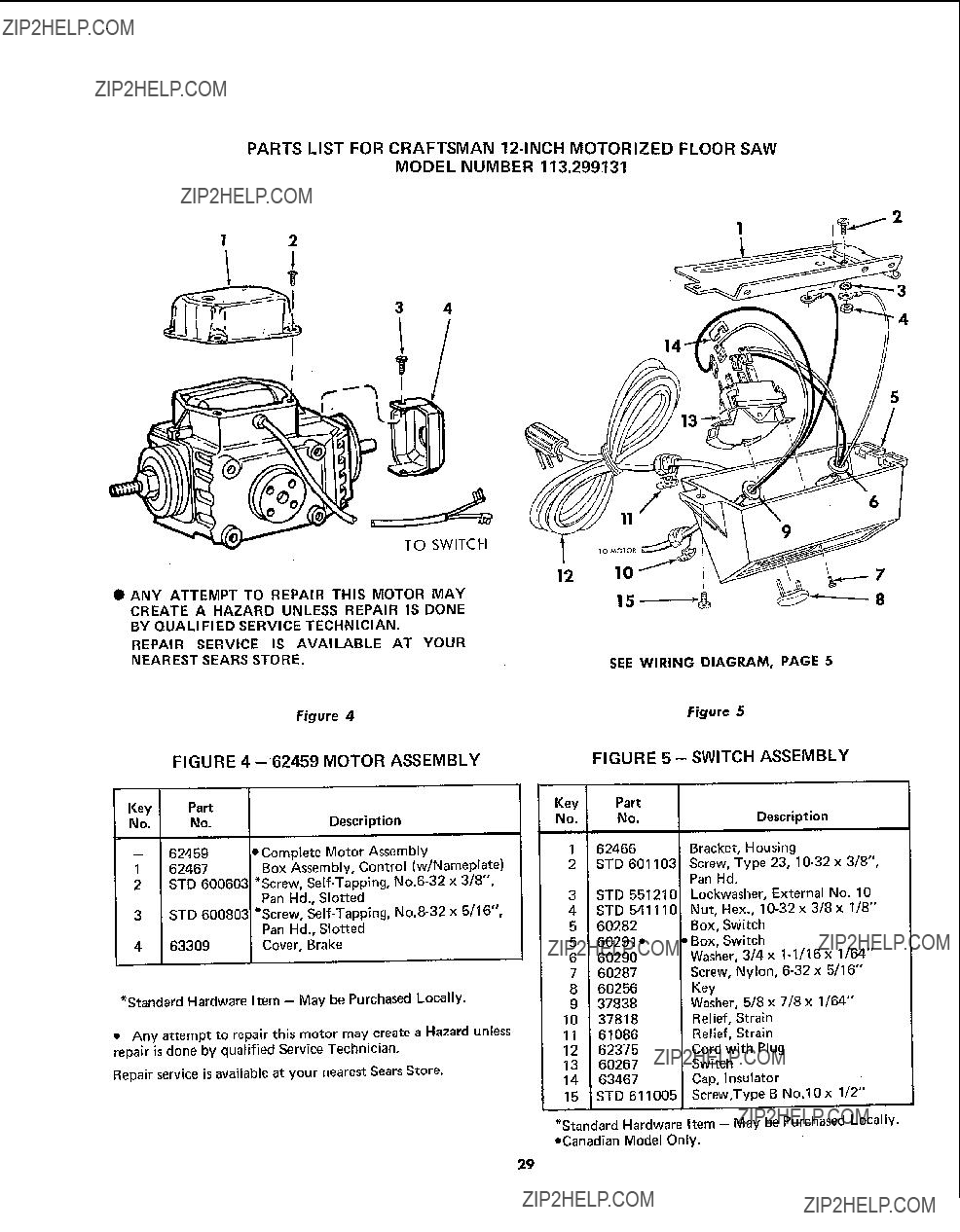
PARTS LIST FOR CRAFTSMAN
MODEL NUMBER 113.299131
12
3 4
I
L
TO SWITCH
???ANY ATTEMPT TO REPAIR THIS MOTOR MAY
CREATE A HAZARD UNLESS REPAIR IS DONE
BY QUALIFIED SERVICE TECHNICIAN.
REPAIR SERVICE IS AVAILABLE AT YOUR
NEAREST SEARS STORE.
Figure 4
FIGURE 4 - 62459 MOTOR ASSEMBLY
*Standard Hardware Item
??? Any attempt to repair this motor may create a Hazard unless repair is done by qualified Service Technician.
Repair service is available at your nearest SearsStore.
11
SEE WIRING DIAGRAM, PAGE 5
Figure 5
FIGURE 5 - SWITCH ASSEMBLY
3STD 551210 Lockwasher, External No. 10
4STD 541110 Nut, Hex.,
*Standard Hardware Item - May be Purchased Locally.
=Canadian Model Only.
29

repair parts
PARTS LIST FOR CRAFTSMAN
MODEL NUMBER 113.299131
Figure 6
???I
FIGURE 6- 62290 RIP FENCE ASSEMBLY
*Standard Hardware Item - May be Purchased Locally.
3O

PARTS LIST FOR CRAFTSMAN
MODEL NUMBER 113.299131
14
*Standard Hardware Item - May be Purchased Locally.
tStock Item
31

Sears
owners manual
MODEL NO.
113.299131
How to ORDER Repair Parts
The Model Number will be found on a plate attached rear of
base. Always mention the Model Number when requesting service or repair parts for your
All parts listed herein may be ordered through SEARS, ROEBUCK AND CO. or
ordering parts by mail, selling prices will be furnished on request or parts will be shipped at prevailing prices and you will be billed accordingly.
WHEN ORDERING REPAIR PARTS, ALWAYS GIVE THE
FOLLOWING INFORMATION AS SHOWN IN THIS LIST.
1.The PART NUMBER
2.The PART DESCRIPTION
3.The MODEL NUMBER 113.299131
4.The NAME OF ITEM -
Sears
SER VICE is at
YOUR
SERVICE wherever YOU live or move
in the U.S.A.
Your Sears merchandise takes on added value when you discover that Sears has over 2,000 Service Units through out the
country. Each is staffed by